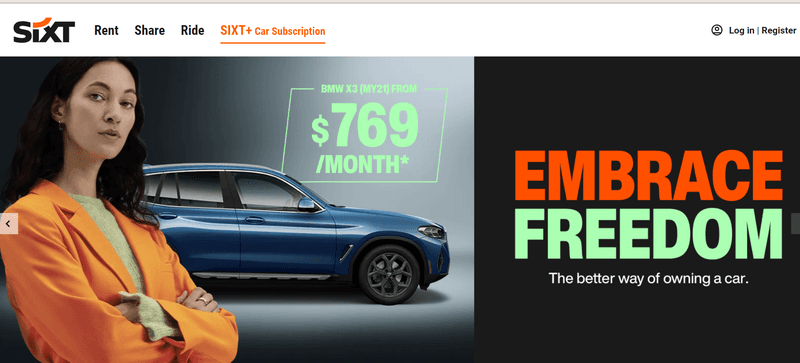Is The Subscription Model Right For Your Business?
Nov 13, 2023
The subscription model fits most businesses, but a few aren’t a good fit. Learn how to separate these and successfully implement subscription pricing.
This is well and truly the age of subscriptions. Every other business and industry is shifting away from one-time purchases, drawn by the many compelling benefits of subscription-based selling.
With everyone jumping on the subscription bandwagon, it’s worth asking if subscription selling is for everyone. Yes, it may be profitable, but is the subscription business model applicable to every business?
The answer is no; not every business is a fit for subscription-based selling. But how do you know if offering a subscription option is worthwhile for your business?
That’s the topic of this article. You will also learn why many businesses now offer customers the option to buy month-to-month instead of in one large payment. And why customers are choosing access over ownership.
Why the subscription model is suitable for both businesses and consumers.

Before understanding why the subscription model may not pan out for some businesses and what these businesses are, we should recap what the model offers both consumers and businesses.
Subscription-based selling guarantees the supply of a good or service or access to a resource in exchange for a weekly, monthly, or yearly recurring payment.
The resulting recurring payments guarantee predictable revenue, which is great for cash flow because you are guaranteed to have money flowing into the business every week.
If you can predict your revenue more accurately, you can also plan more confidently.
The subscription model also allows businesses to build trusted, stronger ongoing relationships with customers. With all the data you collect on how customers interact with and use your product, it is also easier to anticipate customer concerns before they are frustrated into cancelling their subscriptions.
Because you primarily sell access and experiences, the subscription business model gives you plenty of room to change what’s not working. The result is a well-optimised customer experience that recognises that customers’ needs and wants will shift over time.
On the consumer side, the subscription model offers greater variety and cost certainty. Add the ability to cancel anytime, and you have a business model that puts the power back into the consumer’s hands.
Is the subscription model right for your business?
When we think of the best examples of subscription businesses, companies like Netflix, Amazon Prime, Spotify, and Shave Dollar Club come to mind. But in truth, any come can adopt subscription billing and do great with it.
Both startups and pre-existing businesses can adopt subscription-based selling. A going concern can add subscription options or shift its entire sales strategy to subscriptions to leverage a strong brand and tie loyal customers into ‘lifelong contracts’ to boost revenue.
When you look at it, the subscription business shifts focus away from the product to the customer’s needs. It digs deeper to find what customers hope to accomplish by buying your product.
Customers don’t care so much about owning the product you sell. Ownership and everything that comes with it is a burden to them. What they are really after is what your product does for them.
Let’s look at a couple of examples:
When a person a car, what they really are after is convenient transportation. Very few, if any, look at a car as an asset. They want a car they can use anytime, night or day.
So, many would pay monthly subscriptions to a car they can keep, but for which they don’t have to worry about service, insurance, and vehicle licences. On a higher level, they would love a car subscription, like Porsche’s, that lets them use:
the iconic 718 Boxster sports car during weekends,
the sporty yet business-class Panamera sedan for the Monday-Friday work commute, and,
the roomier Cayenne SUV for family vacations.
The cost of buying any of these cars and maintaining them would set you back a few lifetime savings, meaning, for the majority, it would remain just a dream.
According to the fabled sports car brand itself, ‘Porsche Drive puts you in the vehicle that fits your lifestyle’. This is without the burden and cost of ownership.
Another example we can use is that of lawn care equipment. When people buy lawnmowers, leaf blowers, hedge trimmers, and lawn aerators, the image they have in their minds is that of a lush green, well-manicured lawn.
So, a weekly or monthly lawn care subscription would be a compelling proposition for busy homeowners who are pressed for time to tend to their lawn or who can think of more pressing purchases than a garage full of lawn care equipment they would only use occasionally.
To give a few other examples:
Instead of selling expensive boilers, a boiler manufacturer can sell a hot water subscription.
Rather than opening a conventional restaurant and suffering the anxiety of dealing with slow days of the week, you can start a meal kit monthly subscription business that allows customers to create gourmet quality meals at home.
Fitness buffs aren’t looking to own treadmills and home gyms. They want to get fit. So, rather sell a gym membership.
As you can see, any business can implement the subscription model. Now, let’s look at what it entails to offer subscription options in your business:
How to implement the subscription model into any business.
The fear for business owners considering subscription selling is that customers may be unwilling to change their buying habits. The truth, though, is consumers are willing to make perpetual payments to service providers that guarantee they will solve their problems forever.
The problem is most businesses aren’t able to identify what their customers' genuine needs are. Most fixate on their products, forgetting that the success of any product depends on how well it solves the customer’s problem.
In this regard, subscription selling means relentlessly focusing on doing one thing well for customers. It entails picking a narrow subsection of your customers and making them a value promise forever.
The offer to your customers has to be value-centric, anchored on their best interests and capable of being delivered in a predictable way (paid weekly or monthly and delivered on specific quantities and days of the week)
Work out what bigger problem you can solve for your customers. This is the kind of problem you can build a forever solution for.
The resilience and success of your subscription business depend on how well you can communicate the value your product offers to customers. It is your value proposition.
Most consumers can get over the friction of changing their buying habits. They love the affordability of making regular but smaller payments rather than one large payment. So, the subscription model is great for your cash flow as well as theirs.

Even though the overall cost is higher for the customer, they are willing to pay more in exchange for flexibility. For example, with Porshe Drive, the promise of different cars for different purposes without the burden of ownership is an irresistible value proposition.
A subscription service is all about unbundling and repackaging value so customers can see what they are getting for their money at a micro level. The easier you make it for people to cancel, the more people are drawn to your subscription product.
If in doubt, remember that any business is a fit for subscription if they compete for customers at some level. This is especially true for local or B2B businesses with real relationships with customers they know by name.
What if it’s a large physical product?
We have cited the example of Porshe Drive, where the luxury car brand’s subscription allows customers to choose and switch cars between the brand’s iconic model range according to their needs for that particular time.

BMW, another luxury carmaker, is going in a different direction. It is stripping off the premium features of its cars from the regular pricing so customers can customise their subscriptions according to their needs and budget.
So, a fully featured BMW X5 SUV will have all the extras but be available at the lowest trim level because you have chosen not to unlock the luxury features, like heated seats, to keep the subscription price down.
For capital equipment that can set customers off millions of shillings, you can choose to supply this equipment and allow the customer to use it for a monthly fee. Like BMW’s Sixt+ car subscription, all they will have to pay for is the fuel/electricity to power the machinery.
This subscription model is akin to a lifetime service contract; only that you are also adding the cost of using the equipment into the monthly subscription.
These hybrid models that wrap services around your physical product show that there are many ways of implementing the subscription business model.
They are the relationship fix for large, lumpy purchases where the purchase itself can signal the end of your relationship with your customer. It does this by reimagining the value you offer or the bigger, long-term problem your customers want us to solve and the long-term benefit you can offer:
Cars - comfortable, luxury transportation.
Nail salon - Professional nails that look good all the time.
Gardening - a lush green, well-manicured lawn.
If you are unsure about the potential of your subscription offer, start in the corner by picking a very narrow subset of your customers that you can make a lifetime promise to.
This allows you to tweak the offer or its mechanics without aggravating your entire customer base if you figure that your original hypothesis was off.
When should you not implement subscription selling?
Implementing subscription selling is not worth the expense and trouble if your business does not compete for customers. This typically includes businesses that sell patented technology and those that enjoy a geographical or regulatory advantage.
The scope for subscription billing is also limited if you sell true commodities like petrol, coffee, lumber, and sugar. These products are very hard to differentiate between competitors. Consumers usually buy them from the nearest seller.
There are also products that don’t depend on sales and marketing and for which you don’t need to build a relationship with customers. An example is pharmaceuticals. You don’t usually care who supplies your BP medication or where you go to fill your subscription.
Leverage your existing customer relationships and boost revenue with subscription selling.
Increased customer lifetime value, automated billing, predictable revenue, and more opportunities to cross-sell and upsell are all compelling reasons to implement the subscription model in your business.
But before you join the subscription bandwagon, determine if your business fits this recurring revenue model. A simple test is to ask yourself if your business uses regular sales and marketing tactics to win customers.
If you compete for customers, you can offer subscription options in your business. A secondary consideration would be to consider the nature of your product, your industry, and the buying habits of your regular/target customers.
This will allow you to design subscription offers that get to the heart of the problem your product solves for customers.
Ultimately, your success lies in how well you can unbundle the value your product offers, repackage it into cheaper weekly, monthly, or yearly subscriptions, and attract the custom of those who would otherwise not be able to afford lump sum purchases.
If yours is an existing business, you will, however, need to accept that implementing the subscription model may mean overhauling your entire business, which comes with financial risks and complexity.
You may also need to bundle your products into new offers that fit the subscription pricing
model, educate customers on how to navigate this new buying option, and have enough resources to ensure a consistent customer experience.
Ready to implement subscription pricing in your business?
Check Intasend’s subscription and automatic billing software that allows you to create and tailor subscription plans to your business needs and easily integrate subscription payment options on your website. Request a demo or sign up here.

